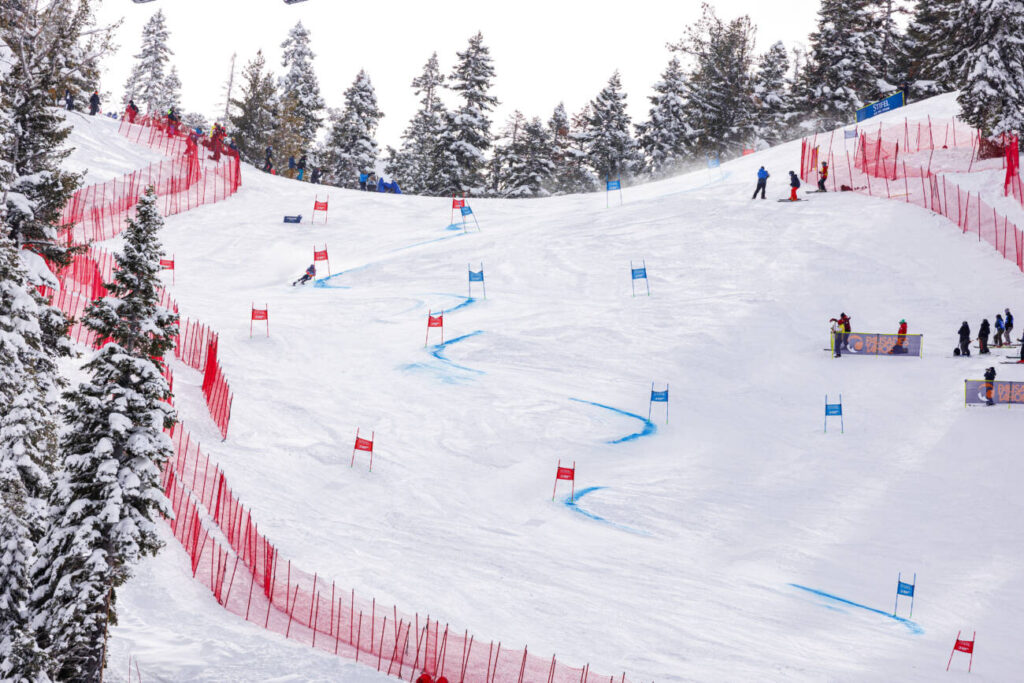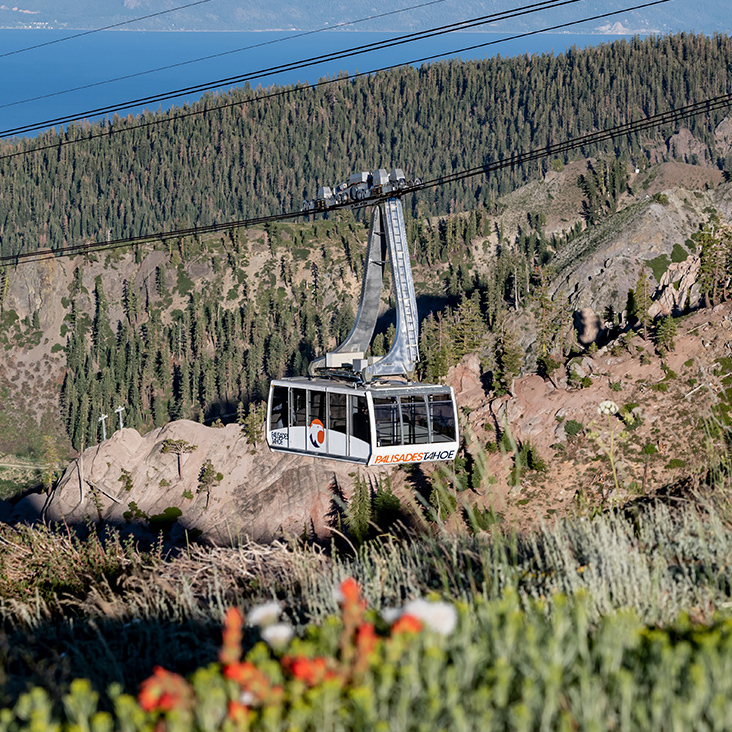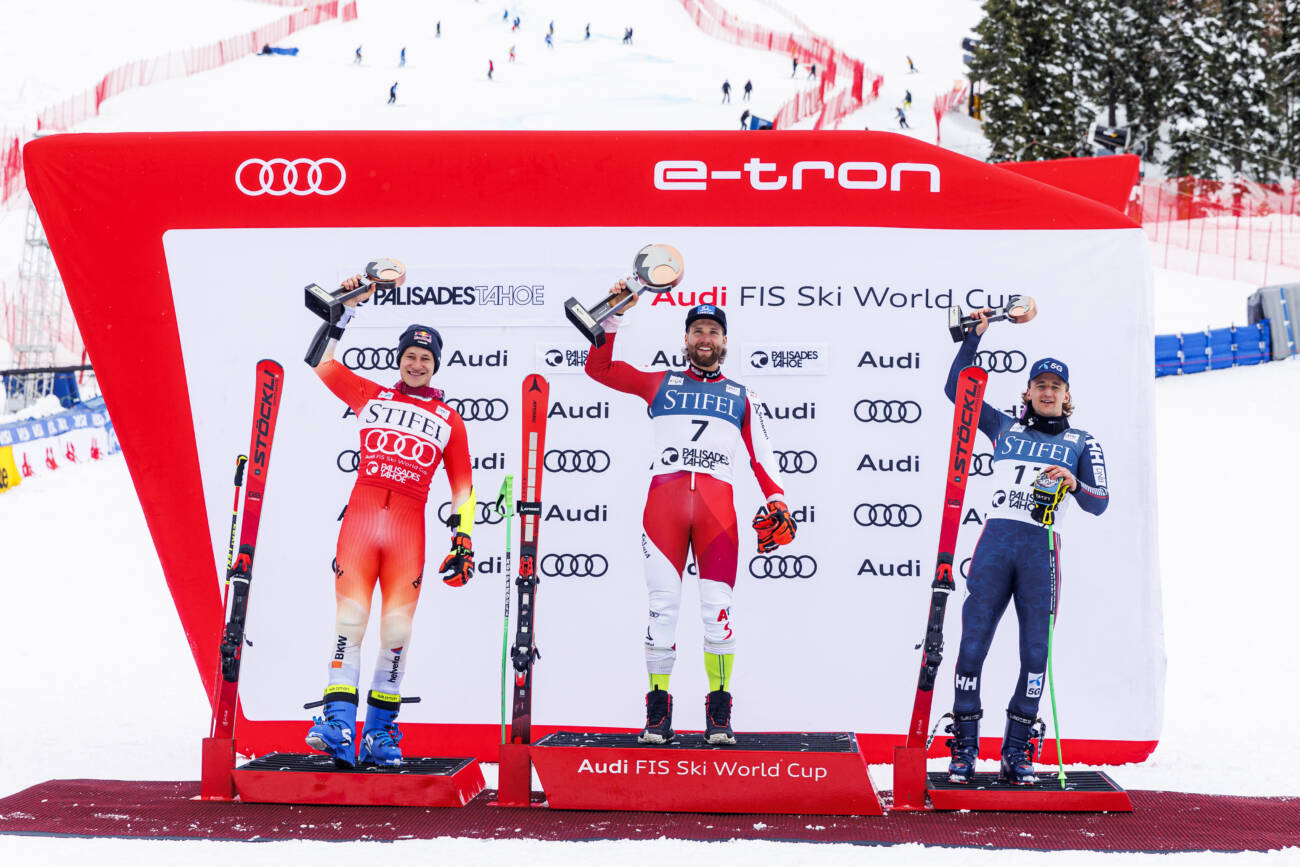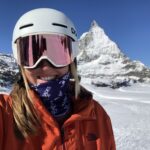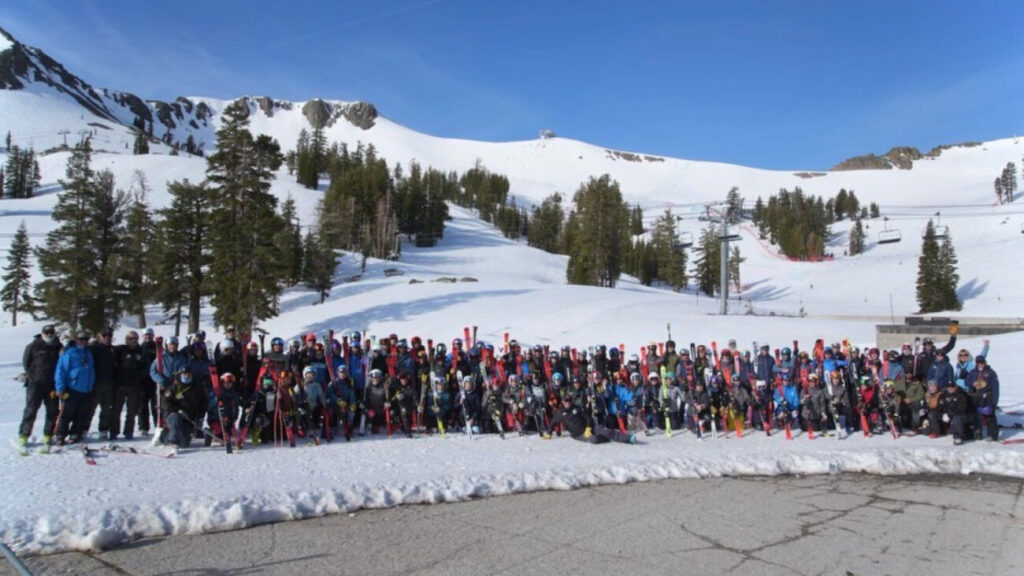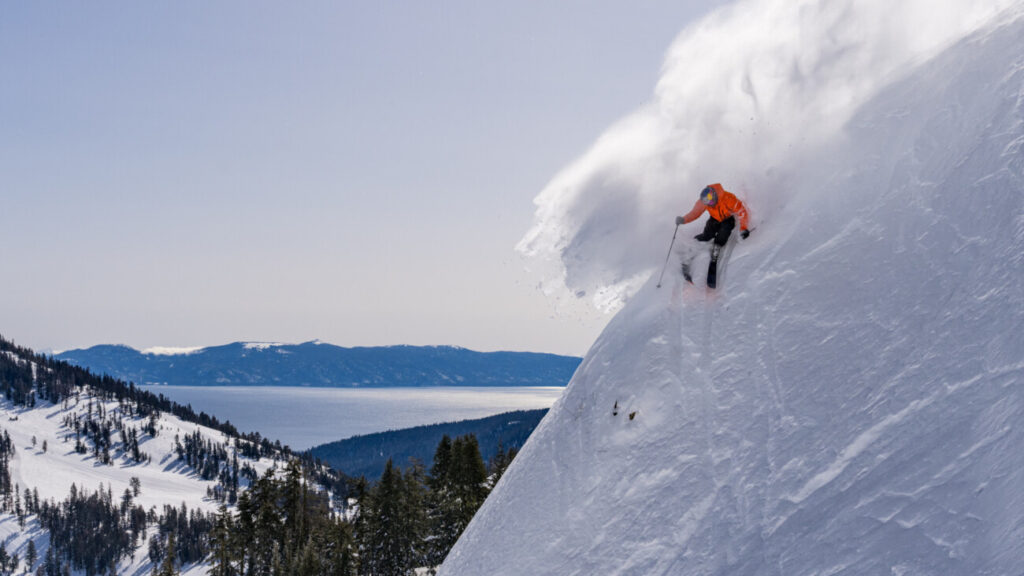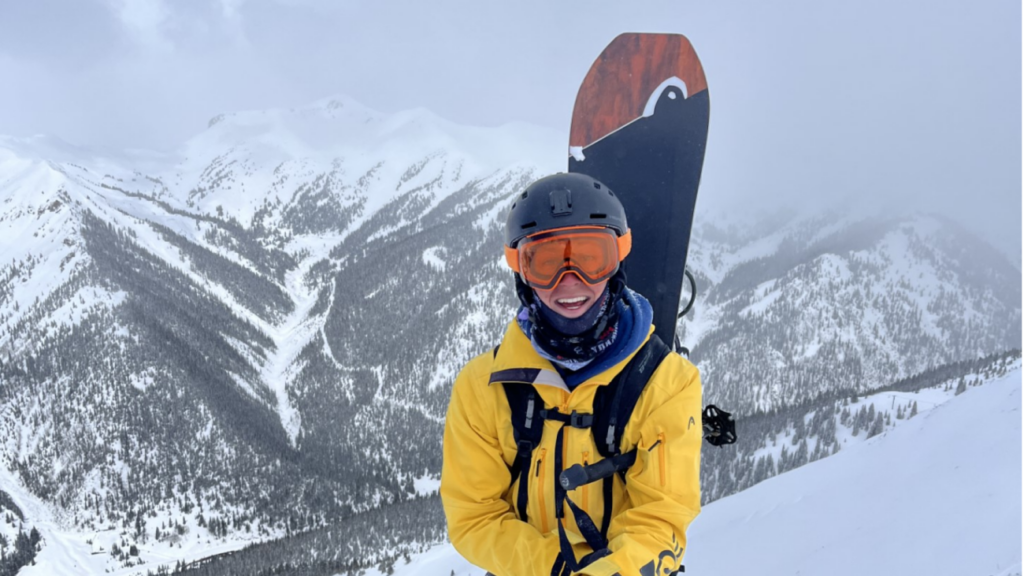This piece was written in collaboration with Team Palisades Tahoe coaches and staff.
Palisades Tahoe, nestled in the breathtaking Sierra Nevada, is the premier training ground for top-tier athletes destined for the highest levels of international competition. This is where champions are forged, legacies are born, and history is made. Rooted in the historic 1960 Winter Olympics, our mountain continues to shape the future of ski racing, setting the stage for the upcoming 2024 Stifel Palisades Tahoe Cup. This is where ski racers will become champions, where legends will become legendary.
What is Alpine Ski Racing?
Alpine ski racing, often referred to as downhill ski racing, is a high-octane showdown between athletes, the unforgiving mountain terrain, and the relentless march of the clock. Athletes must navigate a challenging course adorned with alternating red and blue gates, proving to be a test of agility, precision, and raw power.
Alpine ski racing has its origins in the late 19th and early 20th centuries in the Alpine regions of Europe, particularly in countries like Norway, Switzerland, Austria, and France. The development of skiing as a means of transportation in snowy mountainous regions naturally led to the emergence of competitive events. The first recorded Alpine ski race took place in Norway in 1868.
Palisades Tahoe’s legacy in alpine ski racing dates back to hosting the 1960 Winter Olympics. For that event, Women’s Giant Slalom was held on what is now the Red Dog venue while the Men’s course actually ran down the Nose of KT-22 into Schimmelphfenig Bowl. Since then, we have hosted World Cup races in 1969, 2017, and 2023.
Alpine ski racing has continued to evolve, with advancements in equipment, technique, and course design pushing the sport’s boundaries. Today, events like the Audi FIS Ski World Cup and the Winter Olympics attract millions of viewers from around the world. These events are broadcast internationally, capturing the attention of sports enthusiasts, winter sports fans, and casual viewers alike.
What is the Audi FIS Ski World Cup?
Throughout the winter, ski racers compete and collect points across four disciplines sanctioned by the FIS (Fédération Internationale de Ski et de Snowboard /International Ski and Snowboard Federation): Slalom, Giant Slalom, Super G, and Downhill. These competitions are held at locations around the globe throughout the season.
Think of it as a similar structure to Formula 1 racing where in every race, the better you do, the more points you get. Athletes must look to consistently place well throughout the winter, the season title is awarded to the competitor with the most points at the end.

What is the Stifel Palisades Tahoe Cup?
From February 23-25, Palisades Tahoe will host one of only four US stops on the Audi FIS Ski World Cup tour for the 2023/24 winter season. The Stifel Palisades Tahoe Cup consists of two days of “tech” events with two runs each day: Giant Slalom (GS) on Saturday, February 24, and Slalom (SL) on Sunday, February 25.
Who competes at the Stifel Palisades Tahoe Cup?
The FIS keeps track of points through a complex calculation factoring in past performances. These points and international rankings determine how many, and which, athletes each nation sends to compete. Some athletes compete in all disciplines while others are focused on a specialty.
Who sets the course layout?
The layout of the courses is determined and set by a team selected by the FIS. They must comply with parameters regarding the number of gates, spacing between gates, and snow surface standards for the venue to be approved to hold a sanctioned event. Head to our Operations Blog for a behind-the-scenes look at the steps taken to prepare the snowpack.
How does the skier know where to go on the course?
Athletes get a short period before both the First Run and Second Run for “inspection” where they’ll be permitted to slowly slide down alongside the course. They must study the gate placements and terrain features of each turn. No athletes will be allowed to ski between the gates before the competition, so their first experience at race speed will be when they are on the course for the timed First Run. After the racers inspect and race the First Run, the course is reset. This new Second Run course is then inspected and raced.
During inspection is where the athlete will establish their plan for their preferred “line”. The distance between gates correlates to the quickness needed to transition from one turn to the next, shifting pressure and positioning the skis to make it around the next gate. The ideal line to take is usually somewhere between a high and “early” line and a low or “late” line. If you get behind early on, it can become increasingly difficult to recover. Being “late” to a transition takes athletes off their ideal line and may require them to scrub speed to make it to the next gate. At the same time, carrying too much speed can result in losing control entirely. “Missing” a gate results in disqualification.
Each section of the Giant Slalom course will carry a new set of challenges with big rollers and direction changes giving way to steep pitches. There will be times when athletes cannot visually see the next gate ahead of them based on the slope’s angle. They will need to rely on the mental cues established during inspection to determine their next move.
“A lot of the other Giant Slalom courses on the Audi FIS Ski World Cup tour are a classic, long, top-to-bottom run where you can see a lot of the gates in a row and you can really hammer on the ski and link turns together. On the Red Dog course, every third or fourth gate is blind and there’s a big roller, the terrain changes, and you have to be so on your game and so on your toes. It’s an amazing hill, it’s super fun.“
During the inspection of the Slalom course, athletes will devise a plan to approach the way the course is set, specifically if the gates are set in any “hairpin” or “flush” vertical combinations. These present changes in tempo and direction as the skier works to find a rhythm and the athlete will need to set a game plan around how they want to enter and exit the combination to keep them on their ideal line.
What’s the difference between Giant Slalom and Slalom?

Giant Slalom, Saturday February 24:
In Giant Slalom, the gates are spaced farther apart than in Slalom, but closer together than in Super-G or Downhill events. For this event, the “Start House” will be located directly off the top of the Red Dog Chairlift at 7,520 ft in elevation and run down No Name Face, Dog Leg, around Coaches Corner, and finally down Red Dog Face to finish at 6,293ft.
Giant Slalom is a balance between speed and technical skill. On the Red Dog Course, the spacing between gates for this event will be approximately 22-25M.
“Red Dog is kind of its own beast for Giant Slalom.”

Once they reach Red Dog Face, the course will mandate that athletes string together a series of strong “right-footers” with aggressive pressure on their outside ski to pull them from the far side of the slope towards the center. From here, their legs are burning to keep them on tempo through the final turns as they gain sight of the finish and hear the roar of the crowd.
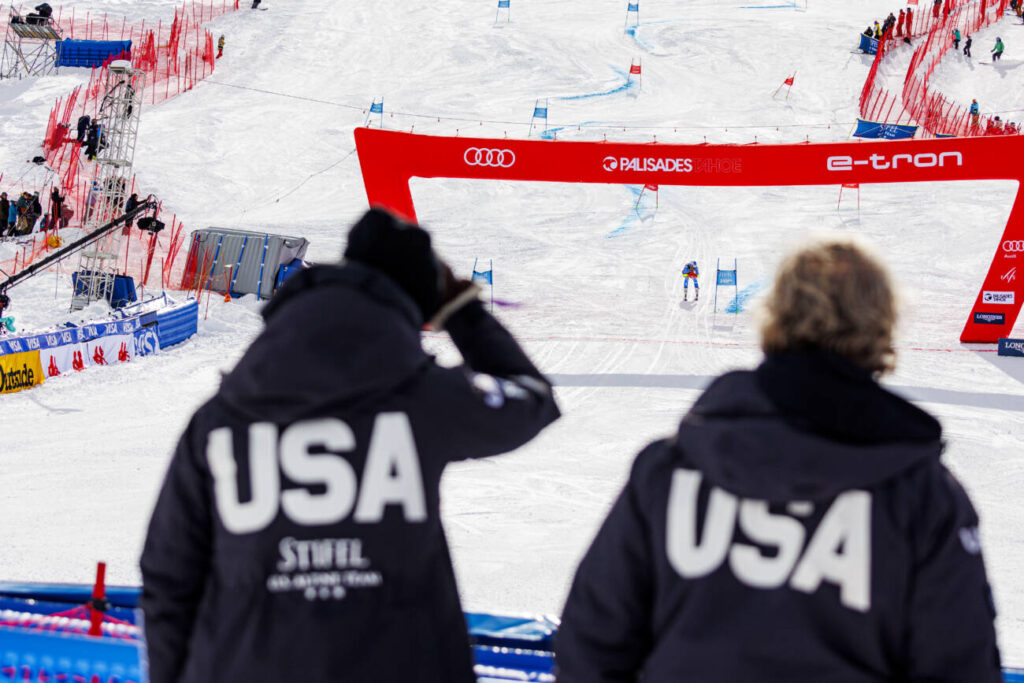
Slalom, Sunday February 25:
In Slalom, it’s all about lightning-fast turns and unmatched agility. The spacing between gates is even tighter, more in the range of approximately 8-13M, with the average time per turn being only 0.8 seconds. The turns are so close that protective equipment including shin guards, pole guards, and a chin guard are worn. To stay in time with the quicker tempo of Slalom, the athletes will maintain a relatively relaxed upper body while using their lower body and legs to carve their skis on edge so much that they go around the gate.

The start of this course is at Coaches Corner near the top of Far East Express. Athletes will take an aggressive push out of the start before entering directly into a dance of left, right, left, right.
The shorter spacing between gates ultimately makes the course shorter from start to finish. With a shorter course, cardio fitness and muscle explosion play a major role in performance. The rapid movements and displays of agility make Slalom captivating to watch, and the results are often incredibly close and competitive. Races are won by hundredths of a second, and athletes competing throughout the season on the Audi FIS Ski World Cup circuit are always pushing each other to be that much faster.
What should I look for as a spectator? How can you tell if they’re going fast?
“First, there are midway times that will be shown on the scoreboard at the bottom of the course. Then while viewing the race, watch for snow spray. This is not fast. The racers are trying to “carve” around each gate. A carved turn is just like a knife carving a turkey. The tail of the ski follows the tip in the same path. Any sideways skidding will be losing speed.
The carved turn should also be round in shape. Any deviation from round is slow. A ski racer’s line that is too far below the gate usually ends in a fishhook shape. This results in a buildup of pressure and the ski racer literally explodes out of the bottom of the turn. Racers call this going to the Red Room… meaning they will end up in the red fencing lining the course.”
Ron Kipp, Team Palisades Tahoe Coaches Education & Development Manager
Why do they get so close to the gate? Why do they “hit” the gate?
Skiers need to get close to the gate to have the tightest and most direct line down the course. Mathematically, this comes out to be less ground to cover, meaning a faster run. The athlete must be able to get the tips of their skis and their ski boots on the proper side of the gate pole. If they contact the gate, it’s less about intentionally hitting, shouldering, or “punching” it. Instead, they are just taking their turn so close that their body is positioned in a way that they end up making contact.
The gates used in these competitions are “break-away” gates, so they are flexible and have a spring-like mechanism at the base that allows them to collapse and pop back up. The athlete will anticipate the contact they will make, but protective equipment and padding make it so that they don’t necessarily hurt.
How do they decide who goes first? Is it best to go first?
The start list for events on the Audi FIS Ski World Cup circuit is determined through a combination of factors including athletes’ rankings, their performance in previous races, and other criteria set by the FIS.
The simple answer is that it’s better to be earlier on the start list – but it’s actually preferred to be in the first seven. This way, you can see other athletes go ahead of you, hear course reports come up over the radio, and use that intel to make any necessary adjustments in strategy before your run. The snow surface quality and density make it so that the course holds up well, but over time ruts start to form around each turn. Going through a rut can cause “chattering” or mess with the fluidity of carving each turn.
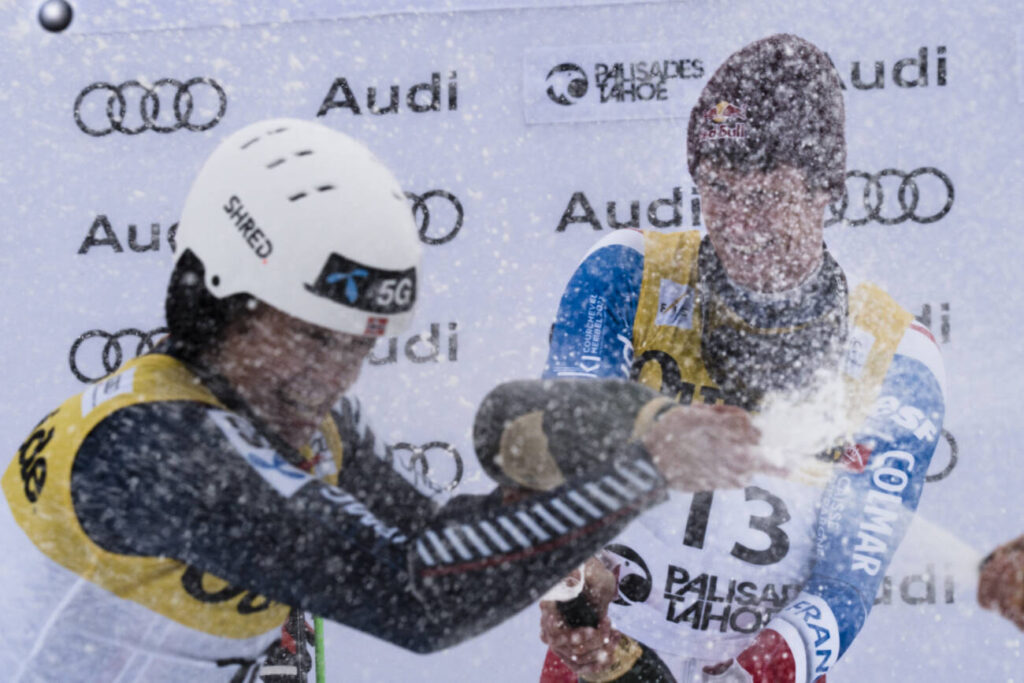
How does the timing system work? How do they determine who wins?
After the First Run, the top 30 finishers are reordered for the Second Run based on their First Run times. Athletes who finish outside of the top 30 on their First Run do not advance on. The fastest from the First Run will start in the 30th position on their Second Run and the 30th finisher will start first. All of the gates are pulled out and reset in a different layout.
The final results represent the combined time between the First and Second Runs each day and every second counts. At this level, the competition is incredibly close – for instance, last year, the difference between 1st Place and 17th Place in Slalom was only 0.96 seconds.
What’s the significance of the Audi Chair in the finish corral?
After the athlete crosses the finish line, they’ll try to catch their breath and look for their final time and current ranking. A green light will indicate if they are the current leader, in which case they will be invited to take a seat in the Audi Chair. As other competitors take the course, each subsequent racer hopes to edge the current leader out of their position. In the Second Run especially, because the top-ranked athletes go last in the 30th position, the finishing times just get closer and closer and the thrill of holding that spot in the Audi Chair becomes more meaningful.
How can I watch the 2024 Stifel Palisades Tahoe Cup?
The best way to get in on the action is to experience it for yourself. Watch competitors descend Red Dog Face and cross the finish in The Village at Palisades Tahoe from the Grandstands or VIP viewing areas. Limited tickets remain for Saturday and Sunday and are selling fast.
VIP packages include exclusive access to a lounge and elevated viewing area, First Tracks early access at select lifts, premier food and beverage options, free parking, and more. Grandstand tickets for kids ages 17 and under are only $25, kids ages 4 and under can access either the VIP or Grandstand area for free accompanied by an adult ticket holder.
The Stifel Palisades Tahoe Cup will be LIVE on Outside for free this season, with coverage also on NBC/CNBC and Peacock. Outside+ (paid) will have all domestic events on demand.
NBC Schedule for Saturday, February 24
- Men’s GS – Run 1 @ 1:00 PM (ET)
- Men’s GS – Run 2 @ 4:00 PM (ET)
NBC Schedule for Sunday, February 25
- Men’s SL – Run 1 @ 1:00 PM (ET)
- Men’s SL – Run 2 @ 4:00 PM (ET)
GET YOUR TICKETS
